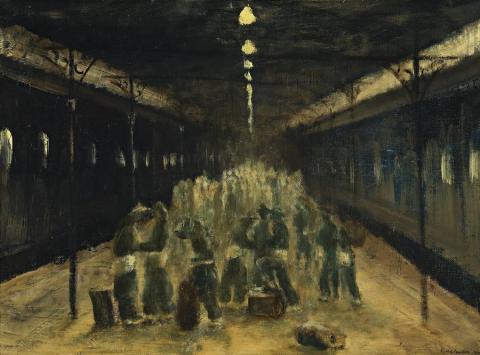BETWEEN TWO TRAINS, 1946
Sali Herman
oil on canvas
37.5 x 51.0 cm
signed and dated lower right: S. Herman, 46
Russell Instone Collection, Queensland
Sotheby’s, Melbourne, 2 May 2000, lot 156
The Hicks Family Collection, Melbourne
S. Herman, Macquarie Galleries, Sydney, 3 - 15 July 1946, cat. 3
Sali Herman Retrospective, Art Gallery of New South Wales, Sydney, 30 June - 26 July 1981, cat. 23
Pearce, B. Sali Herman Retrospective, Art Gallery of New South Wales, Sydney, 1981, p. 43 (illus.)
In January, 1945 it was announced that Sali Herman had won the Wynne Prize for landscape painting with his inner Sydney scene, McElhone Stairs. The Second World War had found Herman working on camouflage like many other Australian artists such as William Dobell and Frank Hinder. He also busied himself painting army life as in Camp by Moonlight and 0630. Such awards as the Wynne Prize, however, invariably bring official notice. In April of that year, Herman was promoted to captain and appointed an official war artist. When on his way to Melbourne by train to be interviewed for the appointment, he had to change trains at Albury because of the difference in railway gauges. The wait was long and crowded, as seen in Russell Drysdale's many fine works of the Albury platforms crowded with Australian soldiers, snatching whatever rest wherever they could. While Herman's painting Between Two Trains shows affinity with Drysdale's works, his figures are more spectral in appearance, set within the sepulchral, overarching station roof, the platform stretching seemingly into infinity. Anonymous, dehumanised figures are herded together like animals for transportation, and a mood of Dostoyevskyian emotional intensity prevails, supported by the limited palette of cool greys and whites.
As a war artist, Herman spent time working in New Guinea, New Britain and Bougainville. Notable among his official paintings in the Australian War Memorial, Canberra, are the hauntingly beautiful Native Graves at Lae, 1945, and Japanese Ack Ack Guns Ready for Surrender, New Britain, 1945. In the former, the white crosses marking the graves metamorphose into crucified bodies, while the covered guns of the latter take on the appearance of great birds of prey now shrouded in silence. The compassionate, humanitarian themes that run through these works came from Herman's Jewish heritage, as did his understanding of humiliation and suffering. This is apparent in Japanese Prisoner, Bougainville 1945 (Australian War Memorial), about which his biographer Daniel Thomas wrote, ‘the crouching Japanese was found in the jungle shivering with fear, waiting to be taken prisoner.’1
In his later work, Herman established himself as the master of the inner-city landscape, revealing the character and beauty of Sydney's old buildings and street scenes that took other Australians years to discover and preserve. This espousal of the inner city slums, of the run-down terraced houses of Kings Cross and Woolloomooloo, once again reflected Herman's sympathy with the underprivileged. Redolent with the people who lived there, he found much beauty in their Victorian charm. Of art, Herman once said, ‘[It] is one of the highest forms of human activity because it is a spiritual act, not just a manual one.’2
1. Thomas, D.R., Sali Herman by Daniel Thomas, Collins, Sydney, 1971, p. 20
2. Herman, S., ’One man's view’, BHP Journal, Melbourne, Autumn 1971, p. 15
DAVID THOMAS
